Research News
September 15, 2017
Publication Features Two Papers on iUTAH Water Science
As the iUTAH project comes to a close, researchers are summarizing methodology and findings as it applies to other water-related research. The September issue of the Journal of the American Water Resources Association (JAWRA) features two in-depth reviews of the mountain urban water system in Utah, specifically, iUTAH design, implementation, and maintenance of sensor equipment, data and metadata produced by the water science project.
The first paper, “Designing and Implementing a Network for Sensing Water Quality and Hydrology across Mountain to Urban Transitions” discusses the logistics of developing and maintaining the Gradients Along Mountain to Urban Transitions (GAMUT) network. The article described the practices followed, as well as insights and findings during the installation and operation of GAMUT. Early on, the research team focused on openly publishing data to drive further science. The research teams “worked to balance scientific needs with physical site limitations, communication constraints, public engagement goals, site security, and partnership potential.” Once the groundwork was laid for the project, additional enhancements focused on quality assurance and system controls to manage and communicate the numerous large datasets produced. The paper finds that GAMUT the "is underlying infrastructure that serves as a vehicle for other research endeavors, ” and instills confidence in consistent long-term data output which secondary users might find helpful after applying their own assessments.
The second paper, “Data Management Dimensions of Social Water Science: The iUTAH Experience” focuses more specifically on integrating a social science framework into the project. It reinforces the first article’s discussion of planning and policy needs, as it explores the open science, data sharing, and the human aspect of Utah’s water system. The study recommends classifying social water science data according to the dimensions of human subject data, primary vs. secondary data, and data restrictions to reveal opportunities and reduce barriers for data sharing. Furthermore, the article concludes by saying that “by facilitating innovative approaches to managing a diverse portfolio of data, the iUTAH program has furthered understanding of a mountain urban water system and provided opportunities for data integration across water sciences and between science and society.”
Full study of each article available below:
Designing and Implementing a Network for Sensing Water Quality and Hydrology across Mountain to Urban Transitions
Authors: Amber Spackman Jones, Zachary T. Aanderud, Jeffery S. Horsburgh, David P. Eiriksson, Dylan Dastrup, Christopher Cox, Scott B. Jones, David R. Bowling, Jonathan Carlisle, Gregory T. Carling, and Michelle A. Baker
Data Management Dimensions of Social Water Science: The iUTAH Experience
Authors: Courtney G. Flint, Amber Spackman Jones, and Jeffery S. Horsburgh
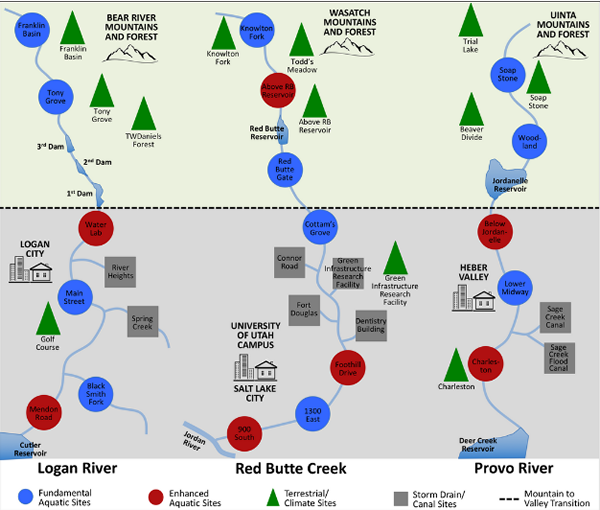
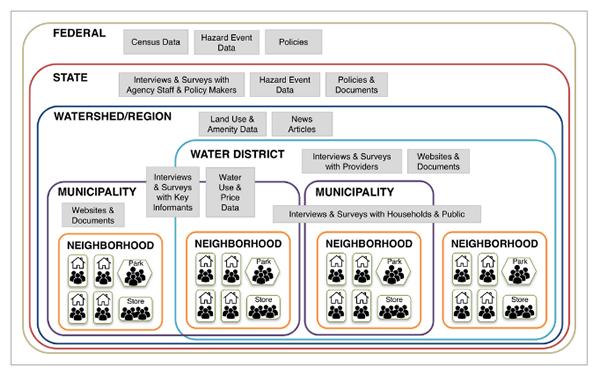
August 16, 2017
iUTAH Research Links Urbanization to Groundwater Degradation
In a recent paper published in Environmental Science & Technology, iUTAH researchers examined the mountain-to-urban transition in Utah watersheds, specifically Red Butte Creek, to identify mechanisms by which urbanization impacts water quality. The article, published on July 21, 2017, found that urban-driven changes in water quality plays a significant role in urban degradation of surface water quality. After the sample analysis discussions, findings point to challenges of current water quality management and restoration efforts based on the use of popular stormwater management strategies in urban settings. Authors of the article include Rachel S. Gabor, Steven J. Hall, David P. Eiriksson, Yusuf Jameel, Mallory Millington, Trinity Stout, Michelle L. Barnes, Andrew Gelderloos, Hyrum Tennant, Gabriel J. Bowen, Bethany T. Neilson, and Paul D. Brooks.
The article can be viewed under the title “Persistent Urban Influence on Surface Water Quality via Impacted Groundwater.”

Credit: Rachel Gabor, et al.
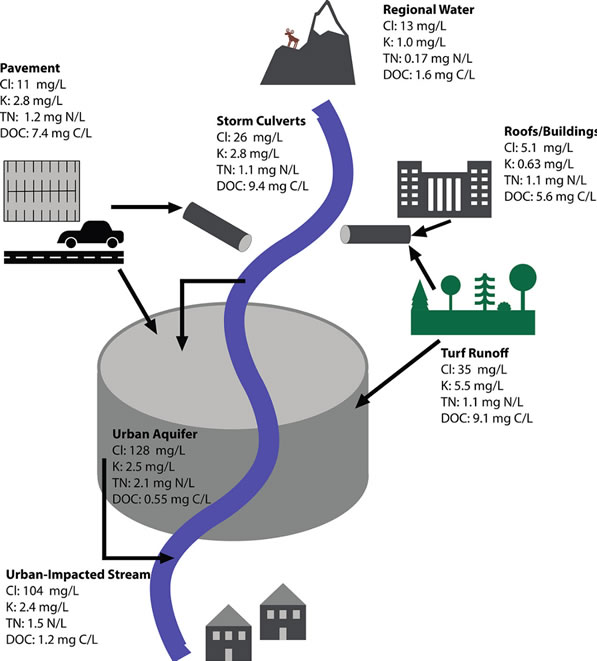
August 9, 2017
BYU Researchers Study Utah Lake Algal Bloom
iUTAH researchers Erin Jones and Scott Collins, along with associate professor Zachary Aanderud and GAMUT technician, Dylan Dastrup, have been in the news recently in connection with their research of Utah Lake’s algae phenomenon. Here’s what the research team and state agencies had to say to reporter Anna Bryner, in an excerpt from the August 3 article in Brigham Young University’s The Daily Universe:
“‘Once isolated, we can put (the cyanobacteria) in controlled environments and manipulate just a few variables at a time to really establish the values for which the bacteria respond by either growing exponentially or producing toxins,’ Jones said.
The team will also analyze the nutrient levels of the varying forms of phosphorous and nitrogen in the lake. ‘We’ll be able to see what factors correlate with the algal growth for the different species that we find from sequencing,’ said Jones. ‘By (taking samples) weekly, we hope to be able to catch conditions leading up to blooms, which is where the environmental triggers actually occur.’
The researchers have also been collecting extra samples to send to the Utah Department of Environmental Quality, where the samples are analyzed to provide information to the public. ‘They’re a real big help for us because we don’t have the resources to go down there on a weekly basis,’ said Ben Holcomb, environmental scientist for the Utah Division of Water Quality.
According to Jones, collecting an extra sample for the department is ‘not really much of a sacrifice.’ ‘They’re spread pretty thin, so we’re happy to do what we can to help contribute to the public health awareness that the cyanobacteria represent,’ Jones said.
As part of the collaboration, the Utah Department of Environmental Quality provides data to the researchers about the analysis of the samples. ‘It saves us a little bit of money and time by them being able to provide that analysis for us,’ Jones said. According to Holcomb, the benefits are mutual. ‘We’re kind of complimenting each other on our needs, so it’s been a really helpful process,’ Holcomb said.
According to Donna Spangler, the Utah Department of Environmental Quality communications director, algal blooms are naturally occurring. The conditions that cause blooms to spread include sunlight, heat, stagnant water and an excess of nutrients. ‘Under certain environmental conditions … (algal bloom) certainly has a tendency to spread,’ she said.”
Read the full article below for more details on how the iUTAH/BYU research team and state agencies are working together to help protect public health.
Press: The Daily Universe | Deseret News
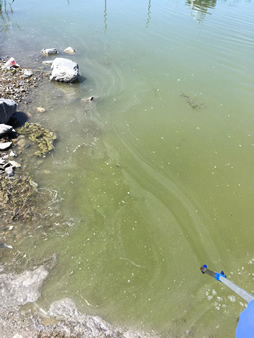
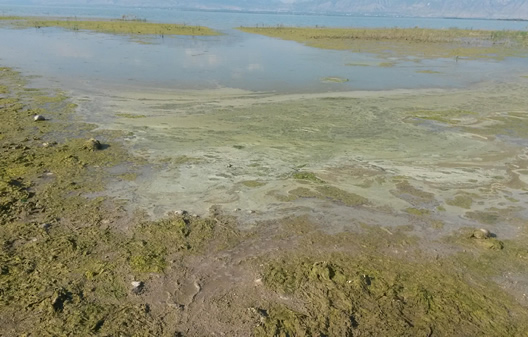
July 17, 2017
USU Symposium Concludes 5-year, NSF-funded Water Science Effort
While attending the final iUTAH Symposium held July 13 and 14, Kevin Opsahl, Herald Journal reporter, highlighted these insights about the project’s origins and impact on the local community in northern Utah. He starts by saying “USU professor Jeff Horsburgh remembers being on a committee years ago with his colleagues from USU and other Utah schools trying to come up with a proposal to get money from the National Science Foundation.
'It was really kind of interesting. We were trying to feel out people from the other institutions because there can only be one proposal like this from the state when we became eligible for this pot of funding from NSF,' said Horsburgh, assistant professor of civil and environmental engineering, before the iUTAH Symposium, July 13 and 14, at Utah State University. 'We emerged with a great proposal.'”
The article also talked with Project Director Michelle Baker who said “ ‘Water is one of our most limited resources for our economic development and wellbeing of Utah’s population,’ she said. ‘Our goal is to really enable people who are interested in science for Utah’s water future. We have programs to stimulate research discovery and training students.’ Baker believes iUTAH’s biggest accomplishment was ‘lowering barriers for collaboration across the state…. iUTAH doesn’t think of itself as a USU project,’ she said. ‘The people from USU who participated in it always tell me the thing they think is the best thing is getting to know their colleagues in Salt Lake City, Cedar City and things like that.’
Lance Houser, an engineer who works for Logan, remembers five years ago when engineers were trying to evaluate the city’s water quality without using extra staff. Houser heard about iUTAH and it turns out USU researchers were curious about many of the same things Logan officials were regarding the city’s water. So Logan provided USU areas in the city were researchers could do sampling and monitoring for water flow and quality.
Houser is pleased iUTAH has yielded results he can actually use. ‘It’s nice to have a program that’s focused on Utah instead of just back east,’ Houser said. ‘A lot of the decisions that have been made in the past have been made on studies and research done in … a lot of areas back East, decisions on management procedures. So, dealing with EPA, we now have another data source that says, ‘Maybe this is not the best approach in this part of the country.’ ”

June 28, 2017
Fighting Wildfires with Wildflowers
Southern Utah University and iUTAH researcher Jackie Grant has been in the news for her award of $68K from the Bureau of Land Management’s Colorado Plateau Native Plant Program to collect seeds from native plants for research. These seeds will also be used to restore plant life after wildfires destroy forests and seeds in the underlying soil.
A media release provided by Southern Utah University’s writer Lexi Carter quoted Grant as saying that “ ‘Native plants are important in Utah because this state is part of a fire-adapted ecosystem, which means that fires happen on a regular basis here,’ said Grant. ‘We need plants to return to the land as soon as possible after a fire to prevent heavy rains from eroding the soil and filling streams with sediment that kills fish. Although we often overlook them, native plants provide the groundwork for what makes this state special.’
The research conducted this summer builds on previous work Grant has done with iUTAH, the state’s National Science Foundation EPSCoR grant. Benefits extend to more than SUU students because water, outdoor recreation, hunting, fishing, and access to the state’s incredible scenery are important to most residents of Utah.
Grant’s collaborations with iUTAH, a statewide research infrastructure improvement grant aimed at water research, education, and outreach, have been recognized with both a Research Catalyst Grant and an Education and Outreach Catalyst grant. A third award for time-release gave Dr. Grant the time to write the proposal for seed collection. "Dr. Grant exemplifies what it means to be an 'engaged scholar,’ said Andy Leidolf, assistant director of iUTAH. “She embodies the objectives of iUTAH's research catalyst grant program and one of our project's core missions: to build capacity at primarily undergraduate institutions.”
‘We are now able to weave science, education and our research through multiple levels of the community while providing experiential learning opportunities to SUU students and recent graduates,’ said Grant. ‘The BLM grant is a fantastic opportunity for the university as it allows us to work with a federal program to provide economic and educational opportunities for the local community of Cedar City.’ ”
Press: SUU University News | The Spectrum
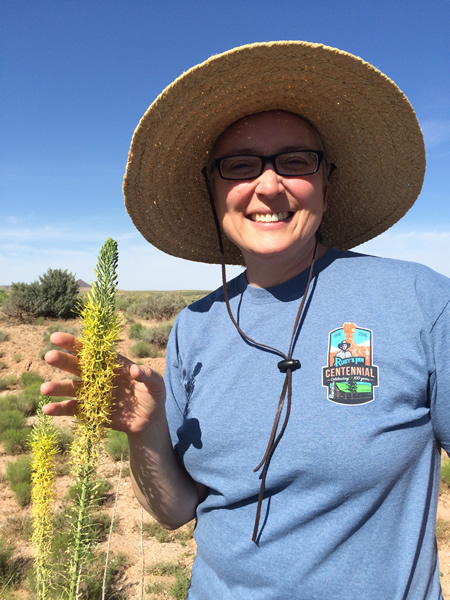
her seed collection and education program. Credit Jackie Grant


